

THE FARM – AN UNNATURAL HISTORY
Many
millennia ago a stone age hunter roaming the valley of Haccombe in South
Devon, fired and lost an arrow. Time passed and layer by layer the vegetation
and soil level grew. The wooden shaft and feather flights of the arrow
rotted away in the dark. The world hurried by. Great oaks grew and fell.
Civilisations came and crumbled. Then one day, over six thousand years
later, a tractor pulling a plough threw the arrowhead back into the sunlight.
The finding of that finely worked flint at Church Farm is tangible evidence
that people lived around here long ago. But then that is hardly surprising.
Just four miles away, at Wellswood in Torquay, the discovery of one of
the most significant p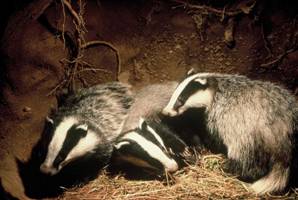 rehistoric
human finds in Britain was made at Kents Cavern in the late 1800s. Here,
among the bones of long extinct animals, many stone implements have been
discovered, along with the hearths of fires lit by the people that made
them. Incredibly, the modern humans that were here up to 40,000 years
ago, were not the first of their kind. Crude stone tools suggest other
closely related people roamed this area up to 700,000 years ago. The cave
has also yielded the remains of great mammoth and woolly rhinoceros, sabre-tooth
tiger and cave lion, hyaena, bear, badger and wolf. Only the badger still
survives as our oldest native resident. The bones of the other animals
provide an extraordinary insight to creatures that our ancestors once
shared this land, and led a way of life we can but only try to imagination.
rehistoric
human finds in Britain was made at Kents Cavern in the late 1800s. Here,
among the bones of long extinct animals, many stone implements have been
discovered, along with the hearths of fires lit by the people that made
them. Incredibly, the modern humans that were here up to 40,000 years
ago, were not the first of their kind. Crude stone tools suggest other
closely related people roamed this area up to 700,000 years ago. The cave
has also yielded the remains of great mammoth and woolly rhinoceros, sabre-tooth
tiger and cave lion, hyaena, bear, badger and wolf. Only the badger still
survives as our oldest native resident. The bones of the other animals
provide an extraordinary insight to creatures that our ancestors once
shared this land, and led a way of life we can but only try to imagination.
The densely
wooded landscape that covered the British Isles must have presented a
real challenge to the first Stone Age farmers. But it was these people
that set a cycle of changes into motion throughout this wilderness - a
wildwood still in the process of forming as the climate warmed in the
aftermath of the last Ice Age.
the last Ice Age.
As
for farming during the Stone Age, 6,000 years ago, little
is known about the nature of the earliest clearings that must have formed
the first fields. However, we do know that the landscape, once dominated
by deciduous woodland, slowly changed until the area of clearings, fields
and pastures, probably equalled that of the woods. Throughout South Devon
a scattering of flint implements of this period have been found and there
is also evidence of an early open hilltop settlement on Haldon Ridge,
at Haldon Belverdere, looking out over the present day lower Exe valley.
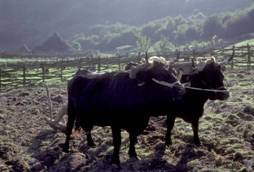 The people of the Bronze Age (2800-600BC) left many more
signs of their living. When seen from the air, evidence of their field
systems still quarter large areas of the South Devon countryside. Today
they survive best of all in the upland, despite their abandonment over
3000 years ago. Dartmoor is rich in Bronze Age artefacts. Here the pattern
of land use was a network of small fields laid out in parallel patterns
on the sides of valleys with the upper moors serving as common grazing.
There is even evidence of similar field patterns to be found around the
Newton Abbot area. But many of the prehistoric features have been lost
in the fertile lowlands and valleys, through subsequent farming activities
and river deposits. Bronze Age people also constructed burial mounds
on remote high open land. Many such tumuli are to found on Dartmoor -
easily seen on a clear day from Church Farm. But other tumuli have been
found much closer to Haccombe. On the high ground of Little Haldon, just
to the north of the Teign estuary, Bronze Age mounds are still evident.
The people of the Bronze Age (2800-600BC) left many more
signs of their living. When seen from the air, evidence of their field
systems still quarter large areas of the South Devon countryside. Today
they survive best of all in the upland, despite their abandonment over
3000 years ago. Dartmoor is rich in Bronze Age artefacts. Here the pattern
of land use was a network of small fields laid out in parallel patterns
on the sides of valleys with the upper moors serving as common grazing.
There is even evidence of similar field patterns to be found around the
Newton Abbot area. But many of the prehistoric features have been lost
in the fertile lowlands and valleys, through subsequent farming activities
and river deposits. Bronze Age people also constructed burial mounds
on remote high open land. Many such tumuli are to found on Dartmoor -
easily seen on a clear day from Church Farm. But other tumuli have been
found much closer to Haccombe. On the high ground of Little Haldon, just
to the north of the Teign estuary, Bronze Age mounds are still evident.
The clearance of the original wildwood and expansion of field systems continued throughout the Bronze Age and into the Iron Age (600BC – 55AD). Throughout this period many field systems were reinforced with banks and ditches, and substantial hill forts began to appear. On Milber down, to the west of Haccombe runs the St. Marychurch Road. It is probably an ancient ridgeway that runs right through the middle of a series of well preserved earthworks on an outcrop of well drained Upper Greensand deposits.
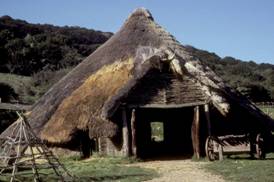 When
the Romans arrived in Britain (55 - 400AD) the existing
field patterns largely survived intact. In some places they were transected
by the invader’s characteristically straight military roads. One
such Roman road ran from their fortress at Exeter, south west to Ashcombe
where it branched west to cross the river at Teignbridge and east to a
crossing below Kingsteignton and perhaps a fort at Milber. Crop marks
suggest that there were also some Roman villas near these routes.
When
the Romans arrived in Britain (55 - 400AD) the existing
field patterns largely survived intact. In some places they were transected
by the invader’s characteristically straight military roads. One
such Roman road ran from their fortress at Exeter, south west to Ashcombe
where it branched west to cross the river at Teignbridge and east to a
crossing below Kingsteignton and perhaps a fort at Milber. Crop marks
suggest that there were also some Roman villas near these routes.
During the subsequent Dark ages (400 – 700AD), there was little further development of the surrounding country except for the establishment of churches and monastic communities.
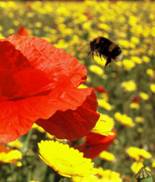 The
Anglo-Saxon (700-1068AD) period saw the creation of parishes
centered on churches. And the establishment of open-field strip farming
began to grow around the first two centuries of this time. It is thought
that a rise in population and shortage of pasture led to a more intensive
use of farmland, along with the characteristic ridge and furrow pattern
of Saxon ploughing. Many examples of which survive in the valleys around
Haccombe.
The
Anglo-Saxon (700-1068AD) period saw the creation of parishes
centered on churches. And the establishment of open-field strip farming
began to grow around the first two centuries of this time. It is thought
that a rise in population and shortage of pasture led to a more intensive
use of farmland, along with the characteristic ridge and furrow pattern
of Saxon ploughing. Many examples of which survive in the valleys around
Haccombe.
In other places a pattern of small irregular fields were established, surrounded by steep hedgebanks, which were often faced with stone. A complex network of narrow lanes following these hedge lines were created to link the growing number of scattered farmsteads. Many of the deep lanes for which Devon is so famous date from this period.
By the time of the Norman invasion in 1066, Haccombe was a bustling little community with a population of some 60 people, bigger than any of the nearby villages. It was owned by a man named Ulf who then lost it to Stephen de Haccombe, probably a soldier in William’s conquering army. Many Anglo Saxons lords gave way to the new ruling class of Normans.
Late Medieval times (1068 – 1540AD) witnessed great expansion and developments of settlements and industry. Several planned towns, including Newton Abbot, were developed locally by the major landowner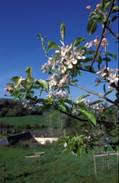 s of the area – Torre Abbey and the Earls of Devon. They also developed
s of the area – Torre Abbey and the Earls of Devon. They also developed 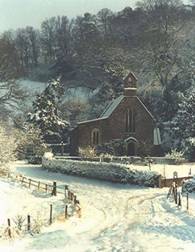 licensed markets for the increasing trade in livestock and farm produce. It was during this time that the new Norman passion for hunting saw many deer parks established on some of South Devon’s great estates. Wool became an important industry in Haccombe and the surrounding areas. Indeed so important that its tiny church, built in 1233, was dedicated to the patron saint of woolcombers – St Blaise. The church was built by Stephen de Haccombe, a descendent of a soldier in Williams Army, who went off to the Crusades. He promised to build a church in the valley if he returned alive.
licensed markets for the increasing trade in livestock and farm produce. It was during this time that the new Norman passion for hunting saw many deer parks established on some of South Devon’s great estates. Wool became an important industry in Haccombe and the surrounding areas. Indeed so important that its tiny church, built in 1233, was dedicated to the patron saint of woolcombers – St Blaise. The church was built by Stephen de Haccombe, a descendent of a soldier in Williams Army, who went off to the Crusades. He promised to build a church in the valley if he returned alive.
The cool spring that flows from the upper valley at Church Farm provided the inhabitants of Haccombe with a vital source of pure water though the centuries. It also provided power. At some time the building of two ponds and the diversion of the stream into a leat, enabled the flow to be managed to power two mills. One mill stood where the present day waterfall now tumbles, and the other adjacent to Haccombe House.
In the Post Medieval period (1540 – 1750AD) the network of roads improved and bridges were built to facilitate trade among the growing settlements. It was also during this time that most of the deer parks were redesigned to form landscaped parkland around the wealthiest country houses.
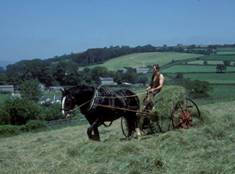
Early modern times (1750 – 1900AD) began with the agricultural revolution. The improved breeding of livestock and intensification of crop production in larger regular fields began a process of great change in the British countryside. With the coming of the railway in 1846 and further improvements in roads, the towns expanded with the rise in local industries such as the mining of clay.
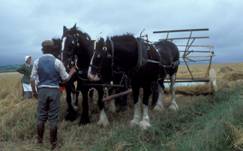 Modern times witnessed the most dramatic changes in our landscape. Since the end of the First World War the planting of vast tracts of coniferous forests has significantly altered the countryside of uplands of Britain. The building of motorways allowed greater ease of movement for people, especially for leisure, and the holiday industry expanded to cater for the growing demand. The last few decades have seen many areas of farmland converted into caravan parks and golf courses.
Modern times witnessed the most dramatic changes in our landscape. Since the end of the First World War the planting of vast tracts of coniferous forests has significantly altered the countryside of uplands of Britain. The building of motorways allowed greater ease of movement for people, especially for leisure, and the holiday industry expanded to cater for the growing demand. The last few decades have seen many areas of farmland converted into caravan parks and golf courses.
Since 1945 changes in agriculture continued at almost reckless pace. Increasing machinery size need wider gates and bigger tractors need bigger fields. At its peak of destruction over ten thousand miles of hedgerows were destroyed each year across Britain. Even Devon was not immune. Thankfully rolling hills and steep sided valleys are not really suitable for intensive arable production. Many areas have, so far, escaped relatively unscathed. Yet new crops, such as the vivid yellow flower of oil seed rape, the pale blue linseed and fields of maize and sunflowers are appearing here and there, while old orchards have steadily declined. At Church Farm and in the surrounding valleys, we still herald the approach of summer with swathes of apple blossom, for this is traditional cider country.
 So Haccombe and the surrounding landscape of Teignbridge in South Devon is rich in the remains of earlier lives. Over thousands of years our ancestors shaped the British countryside, leaving a legacy of farming that brought with it countless wild animals and plants. It is a nature that survives along with medieval field patterns, historic houses and ancient woodlands. These features make our landscape one of the richest and most varied on earth. At least here in Devon they are still linked by hedge banks coloured in wild flowers winding their way through century’s old sunken lanes. The woodlands still burst with bluebell and bird song, and the meadows still dance with butterflies. It may be an unnatural history but the Devon countryside is still one of the most beautiful places on earth.
So Haccombe and the surrounding landscape of Teignbridge in South Devon is rich in the remains of earlier lives. Over thousands of years our ancestors shaped the British countryside, leaving a legacy of farming that brought with it countless wild animals and plants. It is a nature that survives along with medieval field patterns, historic houses and ancient woodlands. These features make our landscape one of the richest and most varied on earth. At least here in Devon they are still linked by hedge banks coloured in wild flowers winding their way through century’s old sunken lanes. The woodlands still burst with bluebell and bird song, and the meadows still dance with butterflies. It may be an unnatural history but the Devon countryside is still one of the most beautiful places on earth.
Read about the Rev Keble Martin, a famous archpriest of Haccombe